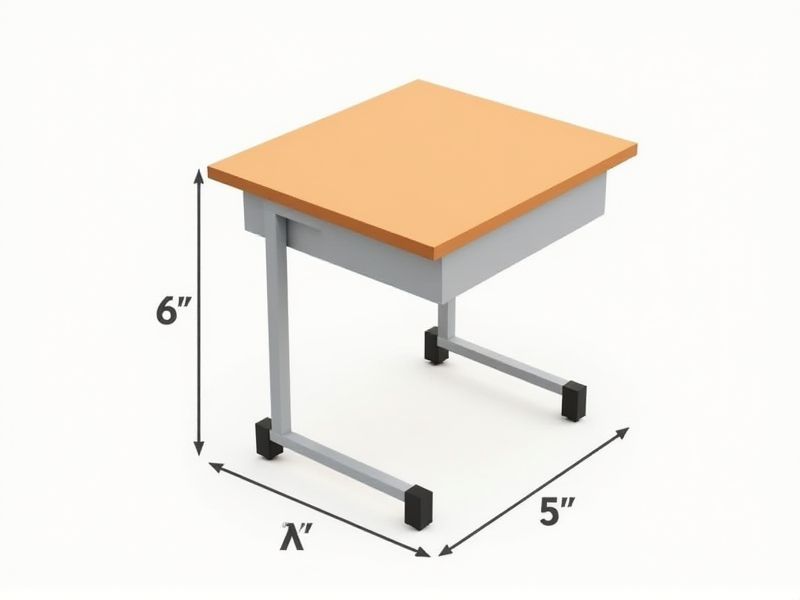
When selecting school desks, it's important to consider standard dimensions to ensure comfort and proper posture for students. Typically, the height of a standard school desk is around 29 to 30 inches (74 to 76 cm) from the floor to the desktop, providing enough space for most students to sit and work comfortably. The width of the desktop usually measures between 24 to 30 inches (61 to 76 cm), while the depth ranges from 18 to 24 inches (46 to 61 cm), offering ample workspace for books and supplies. These dimensions help create an effective learning environment by accommodating a range of student ages and sizes.
Desk Height
The standard desk height in educational settings typically ranges from 28 to 30 inches (71 to 76 centimeters) for adult students, ensuring proper ergonomics to promote comfort and focus during learning. For younger students, desks may vary from 22 to 26 inches (56 to 66 centimeters) to accommodate their shorter stature. Choosing a desk height suitable for your child can enhance their posture and reduce strain, leading to improved concentration and productivity. Consider adjustable desks as an option, allowing flexibility for various heights and preferences, thereby fostering a more personalized learning environment.
Seat Height
The standard seat height for school desks typically ranges from 12 to 18 inches, accommodating various age groups and promoting ergonomic posture. For elementary students, a seat height of about 12 to 14 inches is common, while middle and high school desks often feature heights between 16 and 18 inches. When selecting a desk, it's essential to ensure that your knees fit comfortably beneath it, allowing for proper leg movement and reducing strain. Proper seat height is critical for enhancing concentration and comfort, ultimately contributing to improved academic performance.
Desk Depth
The standard school desk depth typically ranges from 18 to 24 inches, accommodating various body types and sizes for optimal comfort. A depth of 20 inches is often considered ideal, allowing enough space for students to sit comfortably while writing or using a laptop. Ergonomically designed desks ensure that students maintain proper posture, reducing the risk of strain during long hours of study. Investing in a desk that meets these depth standards can significantly enhance your learning environment and promote better focus.
Desk Width
The standard width of a school desk typically ranges from 24 to 30 inches, ensuring comfortable space for students. A width of 28 inches is often considered optimal, providing sufficient room for notebooks, textbooks, and personal items. Desk designs with adjustable widths cater to diverse student sizes and preferences, promoting ergonomic comfort. When selecting desks for classrooms, consider the overall layout to maximize space efficiency and accessibility for all learners.
Leg Space Clearance
A standard school desk typically provides a leg space clearance of 24 to 30 inches, accommodating a range of body sizes for comfort during long hours of study. These designs are crucial for maintaining proper posture, allowing students to sit with their feet flat on the ground. Desk height generally ranges from 28 to 30 inches, ensuring compatibility with standard chair heights. Prioritizing leg space not only enhances student focus but also promotes overall physical well-being during classroom activities.
Tabletop Surface Size
The standard school desk typically features a tabletop surface size of approximately 24 inches by 18 inches, providing adequate space for textbooks, notebooks, and writing materials. This size ensures that students have a comfortable area to work while maintaining ergonomic principles that promote good posture. Some designs may include additional features such as integrated storage or adjustable height options to accommodate different student needs. When purchasing, consider these dimensions to support an effective learning environment for students.
Backrest Angle
The backrest angle of a school desk significantly impacts student comfort and posture during long periods of study. An optimal backrest angle typically ranges between 100 to 110 degrees, promoting an ergonomic position that reduces strain on the spine. Studies show that desks with adjustable backrest angles can enhance concentration levels by up to 20%, as comfortable seating directly influences student engagement. Ensuring that your school desk is set at the appropriate angle can lead to improved focus and overall academic performance.
Material Durability
High-quality school desks typically feature materials such as hardwood, metal, or high-density polyethylene, ensuring durability and resistance to wear. For instance, metal frames can enhance structural integrity and provide long-lasting use, while laminate surfaces offer easy cleaning and maintenance. With a focus on safety, many desks adhere to international standards for material safety, reducing risks from harmful substances. Investing in a durable desk not only supports students' comfort and posture but also extends the product's lifespan, making it a cost-effective choice for educational institutions.
Ergonomic Design
The ergonomic design of school desks is crucial for promoting student comfort and enhancing academic performance. Studies indicate that properly designed desks can reduce musculoskeletal discomfort by up to 30%, allowing students to focus better on their studies. An ideal desk height ranges from 26 to 30 inches for most elementary to high school students, ensuring optimal posture during long hours of use. Incorporating adjustable features can accommodate diverse body types, making the learning environment more inclusive and effective.
Adjustable Features
Adjustable school desks are designed to accommodate various student heights and facilitate ergonomic seating positions, enhancing comfort during long study sessions. These desks typically feature height adjustment mechanisms that allow for alteration from 24 to 30 inches, catering to a wide range of users. The flexibility of these adjustable desks promotes active learning, enabling students to transition between sitting and standing, which can improve focus and reduce fatigue. Incorporating such desks into classrooms can boost student engagement and contribute to better academic performance.
